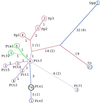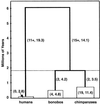High levels of Y-chromosome nucleotide diversity in the genus Pan
- PMID: 11756656
- PMCID: PMC117511
- DOI: 10.1073/pnas.012364999
High levels of Y-chromosome nucleotide diversity in the genus Pan
Abstract
Although some mitochondrial, X chromosome, and autosomal sequence diversity data are available for our closest relatives, Pan troglodytes and Pan paniscus, data from the nonrecombining portion of the Y chromosome (NRY) are more limited. We examined approximately 3 kb of NRY DNA from 101 chimpanzees, seven bonobos, and 42 humans to investigate: (i) relative levels of intraspecific diversity; (ii) the degree of paternal lineage sorting among species and subspecies of the genus Pan; and (iii) the date of the chimpanzee/bonobo divergence. We identified 10 informative sequence-tagged sites associated with 23 polymorphisms on the NRY from the genus Pan. Nucleotide diversity was significantly higher on the NRY of chimpanzees and bonobos than on the human NRY. Similar to mtDNA, but unlike X-linked and autosomal loci, lineages defined by mutations on the NRY were not shared among subspecies of P. troglodytes. Comparisons with mtDNA ND2 sequences from some of the same individuals revealed a larger female versus male effective population size for chimpanzees. The NRY-based divergence time between chimpanzees and bonobos was estimated at approximately 1.8 million years ago. In contrast to human populations who appear to have had a low effective size and a recent origin with subsequent population growth, some taxa within the genus Pan may be characterized by large populations of relatively constant size, more ancient origins, and high levels of subdivision.
Figures


References
Publication types
MeSH terms
Substances
Associated data
- Actions
- Actions
- Actions
- Actions
- Actions
- Actions
- Actions
- Actions
- Actions
- Actions
- Actions
- Actions
- Actions
- Actions
- Actions
- Actions
- Actions
- Actions
- Actions
- Actions
- Actions
- Actions
- Actions
- Actions
- Actions
- Actions
- Actions
- Actions
- Actions
- Actions
- Actions
- Actions
- Actions
- Actions
- Actions
- Actions
- Actions
- Actions
- Actions
- Actions
- Actions
- Actions
- Actions
- Actions
- Actions
- Actions
- Actions
- Actions
- Actions
- Actions
- Actions
- Actions
- Actions
- Actions
- Actions
- Actions
- Actions
- Actions
- Actions
- Actions
- Actions
- Actions
- Actions
- Actions
- Actions
- Actions
- Actions
- Actions
- Actions
- Actions
- Actions
- Actions
- Actions
- Actions
- Actions
- Actions
- Actions
- Actions
- Actions
- Actions
- Actions
- Actions
- Actions
Grants and funding
LinkOut - more resources
Full Text Sources

